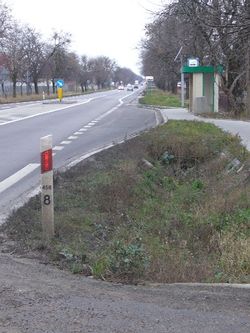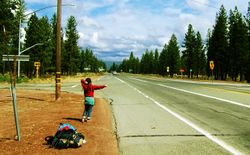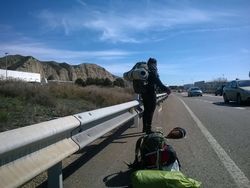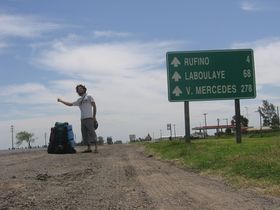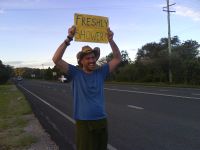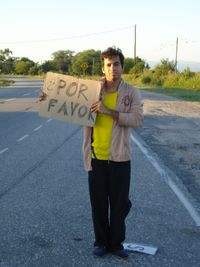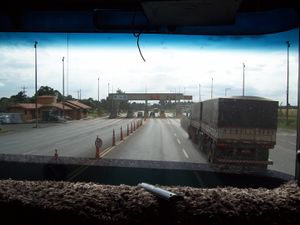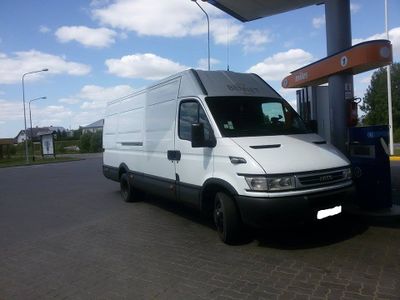Top tips
There are some essential things you should remember when you are going hitchhiking. Hitchwiki suggests you keep these in mind when starting your career as an enthusiastic thumber.
Contents
- 1 Take the most used route
- 2 Carry a good map
- 3 Be in a good, safe spot
- 4 Think positive, stay positive, smile and laugh
- 5 Avoid tight deadlines
- 6 Make eye contact with drivers
- 7 Making conversation with drivers
- 8 Work with the weather
- 9 Types of clothing
- 10 Signs
- 11 Safe hitchhiking
- 12 In the car
- 13 If you're lost...
- 14 If you've gone the wrong way...
- 15 Finding accommodation
- 16 Getting to the nearest city
- 17 Use buses and trains
- 18 Highway hitchhike
- 19 Alone or with other(s)
- 20 Avoid mistakes
- 21 Traveling long distances
- 22 Hitchhiker Tips
- 23 Related links and references
- 24 Nomadwiki & Trashwiki
Take the most used route
The shortest is not the best in all the cases. If there is no traffic, there are no rides to share. Think where the trucks are going: industrial areas, ports/airports, etc.
The fastest and easiest routes are usually ones between two major cities, passing a lot of countryside on the way. If you're planning to go through an area with dense population (eg. Ruhr Area, Randstad, Southeast England) and out the other side, then remember that many vehicles will be local traffic, so it's often a good idea to find a route that avoids these areas or to find a car going through. When going to the South of France from the Netherlands, for example, it might be best to avoid Paris and go through smaller Luxembourg, passing through less densely populated areas, instead.
Avoid trying to get lifts along routes that don't make sense to the drivers; pick a logical A to B route between two major towns or cities that many drivers are likely to be making.
Carry a good map
A list of recommendations can be found in the maps article. You want to know where you are going. It also helps if petrol stations are marked, and you don't need city maps. Try and find a map that you don't have to open out to one large sheet of paper every time you want to use it; you will be using it often. Book-style maps are best. A lot of times, you'll be okay without owning a map, though, if you use your chances well to have a look at one - petrol and service stations and lifts - and keep in mind all you need to know. If you have a digital camera, photographing the map and using the zoom function later has proven invaluable.
It's recommended you have a map that is at least 1:1,000,000 ratio. 1:750,000 is usually good enough. A map with a scale of 1:250.000 will still allow you to recognize enough details to walk somewhere if you get lost. Remember that petrol stations often have maps for sale, including very local ones. If you need to find out the geography of the local area, simply walk into the shop, pick up a local map, study it, get the information you need, then put it back and walk out. Many service stations also have large maps on walls or notice boards.
For the digitally inclined, Google maps now offers the ability to create and save your own routes and landmarks, and to share them. Consider making your hitch-hiking route public with comments about it's hitch-ability.
Hitchwiki spots in combination with OpenStreetMap can also be accessed offline. See High-tech hitchhiking.
For DIY maps i like to write down bigest cities what i should pass and asking a driver to put me out at the best spots to continue my route. Works if your phone with Google Maos screenshots wont starts :D
Be in a good, safe spot
It is basically possible to hitchhike from every place, just keep a single rule of thumb in mind: The faster the cars the more space for the cars to stop is needed.
Be in a place where the cars can see you from a distance and stop safely. You don't want to be run over. This is maybe the biggest danger in hitchhiking. Also, you should provide some space for the driver to stop, not to create dangerous situations for traffic that follows.
This is the case that the drivers consider as well. Few drivers stop unless it is safe for them. Some do, but you shouldn't count on them, as they are the minority. Therefore consider the safety of the driver as well, you don't want to involve them in an accident if they can't pull over safely. Make sure to not stand on the way, the driver will usually make their decision to stop or not when they see you from a distance and will get ready to pull over just next to you or right behind you. If you stand too much on the way (of the normal pulling aside triangle) you will make it complicated for them and they might change their mind. So one good option is to 'make sure' that your body language point out the area they would pull over in total comfort.
Think positive, stay positive, smile and laugh
The results that you get in life are simply a byproduct of your beliefs. So it is very important to belive that hitchhiking will work! Think positive, focus on what you want and tell your friends at what time you will arrive at the latest (like "I will be here for dinner so I will arrive before 7 p.m.!"), even if you don't know how you will manage to do this. Hitchhiker tawax ALWAYS managed to arrive on the day he planned (without cheating) because he is convinced hitchhiking works! Just try it!
Standing on dirty boring roads with loads traffic passing by and no one picking you up is as much a part of hitch-hiking as it is to eventually get picked up by a kind-hearted soul. If you're travelling alone, the road is your only companion that is reliably always by your side. If you can manage to have a friendly relationship with it, you'll have a much more enjoyable experience. Obviously, when travelling in a group, the same goes for your human friend(s).
It is easy to become bored or frustrated when waiting for a ride, but remember that a good attitude will help you get rides. Keep your spirits up by singing, humming, laughing and simply smiling. A grumpy hitchhiker may get rides out of sympathy, but a happy hitchhiker will get better rides and go further distances in less time. If you're in a group, try dancing or clapping your hands at the same time, it makes the drivers smile and lifts come much more often!
If you carry a marker with you, you can even cheer up future hitch-hikers who will use your spot by leaving them little messages on sign posts or crash barriers.
Avoid tight deadlines
It's easier to stay positive when you have nowhere to be. Getting stranded on the Autobahn isn't so terrible as long as you're not trying to meet some friends in Berlin by nightfall; not only are you suddenly worried about how to catch a ride, you don't want to miss out on what's happening at your destination. Hitchhiking is a mental sport, and planning in enough time will allow you to enjoy the road and keep your head in the right place.
Make eye contact with drivers
Hitchhiking means making a connection with a person driving by, convincing him or her to stop. To best do this, make sure drivers can see the 'whites of your eyes'. Remove sunglasses and keep your hat higher on your head. Smile while you look at the oncoming cars. If you are looking a different direction or your head is down it is easy for drivers to pass by without relating to you. If you cannot see the person in the car, just look at the windshield where a face should be. Focus on each car until it passes. If traffic is light, let your gaze follow each car expectantly. If there is too much traffic, pay attention to each nearby car for a moment. If you are walking in between cars, be sure to turn and face cars when you hear them approach. The more you do this, the less time you will wait for rides.
'Mark Snyder and his co-workers (1974) found that hitchhikers doubled the number of ride offers by looking drivers straight in the eye. A personal approach, as my panhandler knew, makes one feel less anonymous, more responsible.' (Source: Social Psychology, Myers. p.503 Social Relations)
Respectable eyes for male drivers and puppy eyes for female drivers seem to work quite well.
Making conversation with drivers
Drivers pick up hitchhikers for lots of different reasons: some because they are genuinely helpful, many because they once hitched themselves, some because they think you might be fun/interesting to talk with. On the chance that they want to interact with you, it is great if you can meet them there in a friendly engaged place. Some hints on how to start conversations are listed under hitching etiquette. Also talking with drivers is the one of the best ways to get longer rides or better drop off places. Have a list of open questions ready: 'Where have you come from today? How long have you been driving trucks? What made you decide to buy this car?' If the driver is reticent it may be that they're still wondering if they've made the right decision in picking you up. Don't be afraid to say a simple 'Thanks for picking me up, it's kind of you.'then going quiet, waiting for them to indicate whether they want to talk. Some drivers are just shy humanists.
Don't underestimate the energy this requires if you do long distances, "for one of the biggest troubles hitchhiking is having to talk to innumerable people, make them feel that they didn't make a mistake picking you up, even entertain them almost, all of which is a great strain when you're going all the way and don't plan to sleep in hotels" (Jack Kerouac, On The Road).
Work with the weather
If it's hot, choose a hitchhiking spot where you can get some shade, in case you have to wait for some hours.
If it's wet, drivers may feel sorry for you, and choose to help you out. No-one likes a soggy hitchhiker in their car, so keep an umbrella handy. Better: stay dry at a petrol station.
Thunderstorms are a blessing. If, during a dry day, you notice that a thunderstorm is coming, don't worry. When the storm hits you, keep you and your possessions under an umbrella and keep signalling. Drivers will feel very sorry for you, and many will stop for you. While waiting on the roadside, Tom was hit by three thunderstorms in 2006, all of which got him a ride in less than ten minutes. The best example was in Cologne - after waiting for two hours without a ride offer, a storm came and there were three offers in five minutes (took the third one, it was a short ride and at the next petrol station another ride came within two minutes).
Types of clothing
Although this may seem to be a small matter, types and colour of clothing are very important. Try to wear light, even bright and colourful clothes, and have your non-thumbing hand visible since light coloured clothes inspire more trust than darker clothes. Also, if the weather permits it, try to keep your forearms visible. If people can see your hands and arms, they'll be less likely to see you as a threat, or as someone trying to conceal something. A fun and colourful clothes/hat is a great way to inspire people to pick you up, but be careful not to appear weird! If you have the option, wear clothes that area clean and decent, even if you've been traveling for days. It's worth keeping a clean 'travel tee' handy just for sitting in the car with your driver.
If you can, don’t wear your old clothes or clothes that might frighten a driver (such as a T-shirt with a skull). Conservative people only take well shaved guys with proper clothes. Liberal-minded people always take you, but even conservative (or old) people can be very helpful on your trip. (I don't think this is of overwhelming importance. I often hitch wearing red tartan pants, punk/metal t shirts and black leather boots and I get rides just as often as the next guy!)
Avoid wearing black. (Not really, it had positive impact (in comparison with a similar trip some time before) on one of my over-Europe hikes where I got on road wearing completely black clothes. Even women were picking me up regularly on that trip.) Even having a smart black shirt could keep you stuck in one place for a long time. Some have found that caps might have a negative impact. (Though Simon from Sweden, with shaved head and beard found it much easier wearing a cap always, because people seem to be afraid of people with shaved heads.) Black or blue woolly hats are awful too. If the weather permits, wear light coloured shorts and a bright colourful t-shirt or a smart short sleeved shirt. Although you may have no choice on whether you have luggage, some hold that hitching without luggage is quicker as the driver knows you're not concealing anything. But some drivers think that carrying a backpack makes you more of a traveler and will only pick up people with backpacks (e.g. Guaka and amylin experienced this in New Zealand). Making your traveling backpack visible could prove to be an advantage as you will have more chances of not being perceived as a threat, as it is harder to run away with so much weight in case you steal or damage something. Stuart at http://lookingforstu.com swears by a Superman T-shirt. It's bright, colourful and is a universal symbol of hope and peace. The amount of times drivers have said that is the reason they picked him up is astounding!
Signs
Just using your thumb or a hand gesture will work fine for hitchhiking, but in most cases, the use of a sign will increase your odds. Especially when you're hitchhiking on a road that goes to plenty of destinations. The driver will be more likely to stop if he knows that you're going the same way he does, and it makes you look like a "proper" hitchhiker.
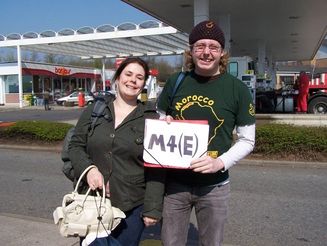
You can write your destination on the sign, but if you're going from Barcelona to Amsterdam, consider writing Paris, or just Perpignan. Few people will be going to Amsterdam or even Paris, directly. There's a dilemma, though, because if the destination you write is too close, you won't make good time, and if it's too far, nobody will be heading all the way there and so won't feel confident in stopping for you. A good solution to this is to simply use your direction of travel, e.g. "East" or maybe "France". You can also add the road name.
It often helps if you write the sign in the same language as the drivers you're trying to attract. If you can show some affinity to the drivers' country, it usually increases your chances of a lift. If you want to make a sign in a language that you don't know, try asking drivers or petrol station staff for help. In countries where hitchhiking is a very common thing to do by locals, e.g. Romania, it could be advisable to make it clear that you're in fact not a local; be it your sign or well-displayed huge backpacks.
To make the sign, use cardboard or similar with a thick black (chalk) marker (e.g. Edding 4090) or India ink (works well with cotton buds). Write a big capital letter and then lower case characters: the varying forms of lower-case letters make at-once reading easier. The more space between each letter the better to be read from a distance.

For long hitchhiking trips you could use an erasable white board. The Velleda 30x44cm is the ideal size and lightweight, albeit not very sturdy. Buy a wide chisel tip dry erase marker such as the Velleda 1781 or the Legamaster TZ150 to write thick lines.
If you apply adhesive tape on the white side of a paper map, you can also use it as a whiteboard. If the map is too big, or if you want to use it in windy conditions, use binder clips. Mine is 80cm x 60cm when spread and 20cm x 10xm when folded. It does take some time to make it nice and flat without any wrinkles. --Strazdas007 (talk) 01:52, 26 August 2014 (UTC)
If space doesn't permit a long city name shorten it to something everyone will understand. For example Amsterdam could be A'dam and Hamburg could be HH. Have a look at the country's license plates, the short forms featured there will probably be known in the population.
Signs don't just have to list a place - Much success can be had (in the proper setting) with more off-the-wall signs like "We're Awesome!", "Free Cookies!", "Runaway Bride" or even "Not Far", "that way ==>", etc. Artwork on a sign can also be helpful, particularly if there are simple images that are commonly related to your context. For instance, when hitching out of Austin, Texas (home of the Longhorns, which are absurdly popular there), adding a Longhorns logo to the sign was a big improvement.
If you have the chance, adding "Please" onto your signs could be a great idea. As well as being polite, writing "Please" in a certain language can indicate that you are a good speaker of that language, and this can be used to attract drivers who were ignoring you before. However, your main message is the destination. "Please" is an extra word for the driver to read. Also, as you're clearly in a desperate position it's already accepted that you are being grateful for any assistance; once a driver stops, you can say "Please" as much as you like. Experiment with "Please" for yourself, and see what happens.
Safe hitchhiking
Wear bright coloured clothes or a reflective warning vest while walking along the road. Next to that, a hitchhiker should consider keeping a small first aid kit with him/her at all times. While these might be mandatory in many Western European countries, not every driver on the planet carries these with them. In terms of an accident, the most dangerous part of hitchhiking, these might come in very helpful, especially when travelling in remote areas of the planet.
Say no, if you don't feel safe! Trust your instinct, when it says no. This doesn't happen often, though. Minimizing risk is not being a coward, it's being smart. If you don't feel comfortable with someone, just don't ask him/her, there will be enough other cars. Most people who pick up hitchhikers are friendly and don't mind a no.
Tip: If you want more security, send an SMS of the number plate of the car to a friend (or at least pretend you do so). A nice way of getting out of a car without offending a driver if you're uncomfortable, is to pretend that you're going to be sick. Tell the driver not to wait, and run away from the road. If you should need to get more radical, a pepper spray or a pocket knife may help and improve your self confidence. (A knife may be a confidence booster but is useless in a situation turned bad. By the time you have your knife out it is probably too late, it can be used against you. The most important thing is to get out/away from your attacker. Pepper spray is probably a better option (if legal). Putting all protective techniques aside you're probably safest traveling with a friend/partner or a fellow hitchhiker.
Girls check out the safety guide tailored to your needs at http://girls.hitchbase.com
In the car
Once you've actually managed to get in the car and start heading towards your destination, it's all a matter of being courteous. Remember, your driver didn't have to pick you up at all. Settle in, get comfortable, but of course, not too comfortable. Keep your shoes off the dashboard, don't pass any form of gas (from either end), etc. In other words, don't do anything to offend your driver!
Your driver may have picked you up for many possible reasons. One of the main reasons is companionship on a long journey. That means you have to talk to the driver. Have a few things to talk about in mind before you get in (What's your name? Where are you headed? Oh yeah? What's there?). If the driver doesn't seem too interested in talking you can relax or read a book.
If not, keep it simple to begin with. A solid rule that should be followed by any hitcher is to try to shy away from talking about politics with a driver who has differing view points than yourself. People have a tendency to get worked up when it comes to politics or religion, so if they mention something that your political or religious views disagree with, try to use a reply like "I'm not going to get into that", "I never thought about that", or pretending to be in vague agreement. Many hitchers have been thrown out of cars following a fiery political debate.
Some drivers will go a few extra kilometres off their route to help you, if you ask very nicely; be prepared to graciously accept a no, however.
Make sure you know where the driver intends to drop you off, and if you know the city or have discussed the city with the driver, try to choose the best drop-off point yourself; drivers can sometimes be "trying to help", and despite their best intentions leave you in what turn out to be very bad places. If the drop-off point is not helpful to you, then say so, and the driver may take you to a different location instead, particularly one on their way.
Don't get lost while you're in a car! Some drivers have a terrible sense of direction and may need your help; so keep track of your journey using road signs and your maps. Also, knowing exactly where you are when you leave the vehicle will save a lot of time; if necessary, ask the driver exactly where you are.
Stuff
Keep your stuff organized. Make sure you don't lose any of your own stuff and very important for the image of hitchhiking: make sure not to take anything that's not yours. That includes watching out when you leave the car.
If you're lost...
...then it's maybe a good idea to stop traveling until you know where you are. Ask whoever you can for help. Look on road signs for city names and road numbers, and try to match them with your map.
If getting lost isn't a problem because you have no fixed destination, then stop worrying and enjoy the ride ;).
If you've gone the wrong way...
...then work out whether it's best to turn around, to carry on in the new direction (either trying another route, or changing your destination), or to stop hitchhiking. If you're on a motorway, then it might be tough to turn around.
If you decide to turn around, then watch out: it can be hard to find a lift that gets you back to your route, and travels in the right direction. You could easily get back to your route, and have to turn round a second time.
Finding accommodation
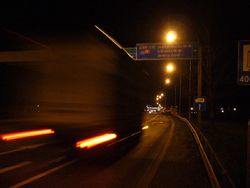
You are sure to reach your destination before the night
If you make small distances, you can plan in advance where you will sleep. If you have Internet access, you can check out those websites for free accommodation: Trustroots.org; hitchhiker centric BeWelcome.org; CouchSurfing.com most active Hospitality Club (good for finding phone numbers in smaller places). If there's a YMCA centre in town, see if they have a room for the night.
You are not sure to reach your destination before the night
On longer hitchhiking trips, you may need to sleep along the way.
If it's not too cold outside and if you have a sleeping bag and a tarp or a tent with you, begin a few hours before the sunset to look out for places where you could sleep. It may be a hidden place in nature, McDo games, or an uninhabited house.
If you don't want to sleep outside, consider those possibilities: Are you ready to pay for a hostel? If yes, can you find one? Is there a (big) airport on your road or close to the place you are? You may sleep there. Can your driver host you? Can you find a car/truck driving overnight and crash out on the way? In this case, is the driver really reliable?
Holding a big "Couchsurfing?" sign in public place
Strazdas007 says it is possible to find a host in this way, but you must know, where it is biggest chance that your sign will be seen - talking about subway stations or even stations in general, bigger supermarkets, town squares. He actually found one host near some touristic attraction - somewhere near Eiffel tower, but he was lucky, because next day he wasn't so lucky and had to sleep on the bench. And he was thrown out of the subway station in Paris, because guards were thinking that he was asking for money. Or you can simply look for some hipsters, or simply friendly youths and ask them if they are hosting, if they don't know, tell them about CS'ing, and maybe they will host you.
Try your luck. And remember this is not hitchhiking, eye contact is almost pointless, because your sign is making contact. Try to make sign as big as possible (well not very big, but so it could be seen from further or/and attract people eye).
Camping
Wild camping how to http://nomadwiki.org/en/Camping
Other options
If you can't find anywhere to sleep, there are still other ways to get out of the situation. If you are lucky enough to be at a 24-hour petrol station or Mc Donalds, just keep drinking coffee and keep hitching through the night. Keep in mind that it gets really quiet between 2:00 and 5:00, even at motorway service areas.
Getting to the nearest city
It's tough to hitchhike out of city centres. But sometimes (if you're tired, hungry, thirsty, ill etc.) you'll need to go off your route and take a pause in the nearest city. Hey, if you're flexible with your travel arrangements, you may decide to stay there for a bit longer...
If hitchhiking to the city is too hard for whatever reason, and the city is too far to walk, then take public transport. Head for nearby areas of houses: they often have bus stops.
Most petrol stations on motorways have a special access road for staff and delivery/emergency vehicles. Many petrol stations also have local maps you can look at to find bus stops near you, if you exit via the special access road.
Use buses and trains
It's not worth trying to hitchhike at all costs. Sometimes it's just more convenient to take a bus to get to a highway or to your final destinations. This is the case especially when leaving or arriving at big cities or at night. Sometimes you can get away without paying on public transport, although in some countries or cities you have to be more careful than usual: check a "Public Transport" (or "Blackriding") section (if there is any) of a country/city you travel to. If you do blackride anyway, sit or stand preferably by the door; sometimes quick reaction (last second jumping off) to suspiciously looking folks who might appear to be ticket controllers can save your butt. It is usually better to sit in the front of the bus so you can quickly scan all the people waiting for the bus while the bus approaches the station and stops. Also, it helps to direct sight in only one way to look for ticket controllers you missed before already in the bus.
Highway hitchhike
If you need to travel over long destinations, taking the highway is the best option. Most highway entrances are bad spots, and many are dangerous. A good way to hitchhike on highways is to practice "station hopping": you only stop in petrol stations or rest areas. There you can talk to people and the car is totally stopped. You could also hop off at a toll station. Take a map which shows the petrol stations!
In most countries, hitchhiking directly on the highway is forbidden! In rare occasions however, you might be forced to. Keep in mind that it is very unsafe for drivers to stop on the highway, and that your own safety is also in danger. The police might force you to leave the area and could fine you.
Alone or with other(s)
Hitchhiking is considered to be fastest for a solo female hitchhiker, but it supposedly is a bit riskier. If you're two or even three, you can travel fast as well. Keep in mind that truck drivers often only have one "official" extra seat. By preference take one bag instead of two. If you're more than three it would be a good idea to split into several groups.
If you're not traveling solo, the other person(s) can wait on a place not visible by the oncoming drivers, but not too far from the hitchhiking spot. You can also do this if you have a lot of luggage. You might get some people to stop that would not otherwise do so if they saw more people or extra luggage, and it's harder for them to reject you once they have stopped.
Fverhart (male) has a 5% faster "waiting time / ride distance" ratio for hitchhiking with one female companion compared to hitchhiking alone, and 75% longer "waiting time / ride distance" ratio for hitchhiking with a male companion (derived from data collected from 1,641 rides, of which 1,299 alone, 189 with female companion and 132 with male companion). His data for other combinations (more than two hitchhikers) are not reliable, due to lack of statistical significance (only 21 registered rides).
Avoid mistakes
Last but not least, try to avoid common mistakes and you will save a couple of hours and loads of frustration.
Traveling long distances
When traveling for long distance when you arrive to a big petrol station you should prioritize some drivers like:
- Transportation vans: They usually are not so big and there have 3 seats in the front so if you are hitch-hiking with a friend is perfect. Inside you will probably see something to contain coffee and the front will be full of killed mosquitos.(these are good indicators). So these drivers usually drive non-stop just to deliver their stuff from one place to another no matter what. Be warned, that crossing Polish - Lithuanian border zone with these drivers can be nervous and lenghty, because of police. They usually stop them to inspect cargo, or to check if car is not overweighted (drivers say, that if they know that there is overweight, they usually bribe cops, so it happens faster.), documents are checked, and you may be asked for your documents too, so be prepared. Unlike truck drivers there is no regulations for the time they can drive so they don't have to pause for rest and they can reach 160 km/hour or more (instead of 90 km/hour or even slower 80km/h).
- Businessman / expensive cars: some tend to be really nice, have been hitchhiking couple decades ago, and you get to ride some nice cars.
- Holiday vans: The drivers can also do long distances and some can travel for months.
- Truck drivers: They quite often cannot take anyone legally because of the insurances but always ask them about the possibility. Two persons is more complicated but the bed behind the seats can be good to hide your friend. They are good for overnight trips, as you may ask driver if you can sleep in bed.
Hitchhiker Tips
This is the section where anyone can write his or her practical tip. My idea is to try and make of it as much science as possible so here are some ground rules:
- Everybody are welcome to share their knowledge.
- Read all tips prior to adding on in order to prevent:
a. Writing the same tip. b. Writing contradicting tips which may confuse others.
If you disagree with a tip been written discuss it on the discussion page.
- Try to add tips base on theories being tested. (Example curves: try do exactly the same on both sides on various occasions and record your time and percentage)
_________________________________________
My hitchhiking theory: Hitch hiking is a game of patience and mental strength. Be prepared! Although agree with the article above i believe the vast majority of drivers pick up hitch hikers on psychological association based on looks and self interest which sometimes seem random. That is why we should do anything we can to maximize our chances by looking as trust worthy and average as we can as well as consider the drivers interest.
- The Average Driver - the average driver does not understand hitch hiking and that is why you will get a lot of gestures from drivers indicating they "stay in the area" or "not going far". It does not occur to them that even a 10, 5 mile or "only to the next junction" ride will advance you and will have critical positive mental effect.
- Clothing & Appearance - since our goal is to get from point A to B, without importance of who is going to pick us up we want to look as trust worthy or "good, nice, harmless guys" as we can. That means dressed in quite a popular way to the place you are in. Usually it means shorts/jeans and T-shirt (preferably light color) for boys and girls and possibly dress for girls. Of course working according to situation is better, i.e. hitch hike to a metal concert you might dress all black with anthrax T-shirt and 10 piercing in your face and probably get a fast, to the spot ride, but the average driver might feel unwilling to stop to someone of "your type" out of prejudice.
- Be ready to walk - Location is crucial and so it is not rare to walk sometimes a mile or even more to get the best position for your next ride. On the way it is fine to try and stop vehicles.
- Curves - If you are near a curve it is better stand about 50-100 meters before the curve since the driver can see you from more far and also is already in the need of reducing speed and mainly his only job is just get to a slow, reasonable velocity to enter the curve.
Standing after the curve would reduce you chance since you're being seen only on when the driver is out of the curve and is already in the task of speeding. Less people are likely to step on the break for you once they started speeding. Standing in the middle is extremely dangerous and the least efficient since the driver is multitasking.
- Up & Down Hills - If being on hilly topography it is better to stand on the first third of the up hill side. As on curves people are more likely to stop while they are already slowing down.
The top of the hill or close to it wouldn't be a good place since the driver is focused on getting to the top. If a down hill is right after most drivers would not stop for the fun part. Down hill again is a bad place to try and stop the driver since he is gaining speed and not likely to give up on it.
- Gestures - Different gestures can steal the attention of the driver and gain you a ride.
All in addition to smilling and looking to the drivers eyes:
- Wave the hand in between to passing cars.
- Pointing-moving your thumb every now and then above your shoulder towards the direction.
- Even single a "little" gesture with the two fingers helps, as explained on "the average driver" section. That is where board usually comes in super handy.
- Asking for Ride - Don't be afraid to talk to people and ask them directly if you can hop on. Some drivers would not consider taking you, yet by hearing a nice, friendly, polite voice they might will as well as feel a bit more obligation to help you.
Different Vessels
You should feel comfortable through out the whole way to your destination. if you feel uncomfortable hoping on a specific vessel - don't. As it will tire you out and make a bad experience for the future. If you feel unsafe with the drivers drive don't be ashamed to tell him (I do ask all motorcycle rides to drive relatively slow especially on unpaved roads, never needed to tell in a car) he will understand your worry, remember he stopped in order to help and will be nice enough to make you feel comfortable.
- Back of a Pick-Up Truck - The back of a pick up truck is where you are likely to spend a big chunk of the road. However there is a clear problem of safety. For the driver it might be convenient to tell you to hop on the back and so he wont need to worry from a dangerous hiker or either talk in case he isn't in the mood. It is also an extra space in case the seats are full. On the hiker side you have zero control on what is going on and hop on without at least getting to know if the driver is trust worthy is not recommended. You should have a few words with the driver about the way and agree on a place before hands since you wouldn't be able to converse once you start driving, knocking on the roof for stop at most. There is also the problem of sitting without safety belt and potentially with unfasten equipment that might hurt you in case of emergency stop, curves or irresponsible driving.
- Motorcycles - Motorcycles are somewhat problematic when it comes to travelling with luggage, yet is possible. It is a good way to travel fast, but just like driving one - even less safe as taking a ride with a car. Try to ask the driver for an extra helmet. Usually not likely to work, but some drivers keep an extra "half helmet" in the box of the vehicle - not much, but certainly better than nothing. I for instance tend to minimise motorcycle rides since i feel unsafe with a stranger driver. You might ask to drive slower, but remember driving slower means less balance.
My vision is to have a collective grid-table for people to add on theory and different people to add on their tests result and so things would become scientific and clear very fast. Main problem - different countries, different cultures. I hope this section is going to evolve because i would love to see others tips and try to find the ultimate hitch hiking technique.
Related links and references
- Tips for Hitchhiking on Wikivoyage
- The importance of smiling when engaging drivers
- Rules of Thumb - A free guide to living on the road and hitch-hiking
- HitchHikers Handbook - a useful hitchhiking resource with advice on everything from getting started to city guides
- Worldwide Database of Places for Hitchhikers
Nomadwiki & Trashwiki
Check Trashwiki for dumpsters...and share your wisdom :)
